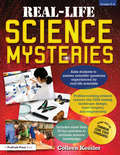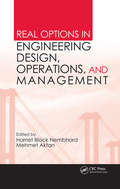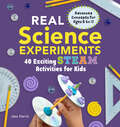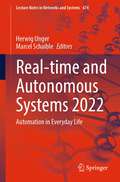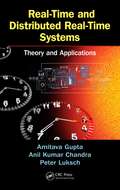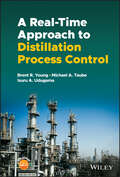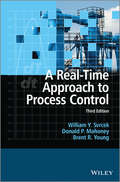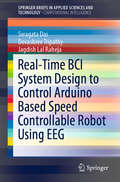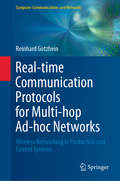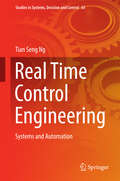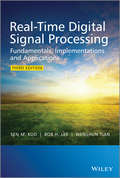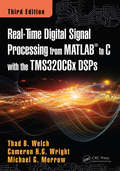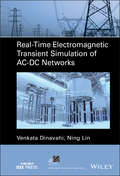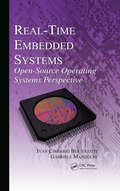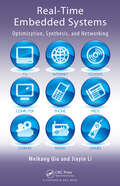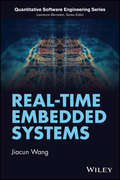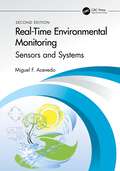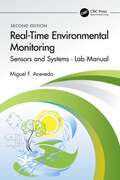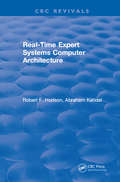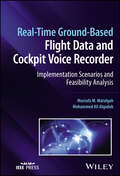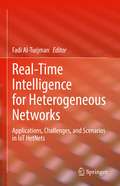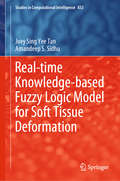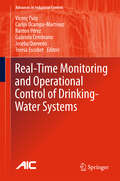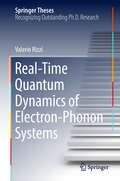- Table View
- List View
Real-Life Science Mysteries: Grades 5-8
by Colleen KesslerReal-Life Science Mysteries puts an exciting new spin on scientific thinking by profiling real-life scientists, showing students in grades 5-8 ways they can use science in their everyday lives. From a biologist studying the habits of garter snakes in Manitoba, Canada, to a landscape designer and greenhouse owner in Ohio, the scientists in this book share information and solutions to the thorniest problems they face in their scientific careers.With the more than 30 activities included in Real-Life Science Mysteries, students will be required to try their hand at solving common science problems and performing experiments while learning about real people from diverse backgrounds, all of whom share a love for discovering how they work, why things work, and how they can work better. This book is perfect for any science classroom or young scientists looking to increase their knowledge!Grades 5-8
Real Options in Engineering Design, Operations, and Management
by Harriet Black Nembhard Mehmet AktanGiven that engineering flexibility can potentially provide a competitive advantage, the question then becomes: Precisely how valuable is this flexibility? However, traditional methods often fail to accurately capture the economic value of investments in an environment of widespread uncertainty and rapid change. The real options method represents th
Real Process Improvement Using the CMMI
by Michael WestReal Process Improvement Using the CMMI (R) presents readers with non-academic, real-world approaches to process improvement via CMMI. The author provides concepts and techniques for CMMI-based process improvement which are as effective as they are innovative. Professionals at all levels from system engineers to CEOs will find a wealth of practical guidance and new ways to look at model-based process improvement that have already benefited large and small organizations in a variety of environments. Using plain language and enlightening illustrations, the author identifies the most critical concepts of the CMMI, and explains how to turn those concepts into real process improvement. This book provides you with key information that will significantly benefit all CMMI process improvement efforts. Topics include: * Ways to discover and understand the business goals and drivers for successful process improvement initiatives * How to recognize the structures and practices many organizations already have in place that can accelerate process improvement, even before they begin using the CMMI * Planning and managing the process improvement project * Innovative, untraditional yet highly effective and proven strategies for CMMI-based process improvement * A thorough debunking of many of the costly and wasteful myths surrounding CMMI-based improvement.
Real Science Experiments: 40 Exciting STEAM Activities for Kids (Real Science)
by Jessica HarrisTake your scientific exploration to the next level with real experiments for kids ages 8 to 12 Here's a hypothesis you can prove: science is a ton of fun! These science experiments for kids give you the opportunity to test this theory using 40 exciting activities that teach you all about science, technology, engineering, art, and math—the full STEAM package! From microscopes and candle-powered boats to insect mind control and hydroponics, these science experiments for kids offer a hands-on approach to scientific discovery. Each of these engaging and repeatable experiments give you the chance to get up-close, personal, and creative with all kinds of amazing ideas that will show you how to be a real scientist. This collection of science experiments for kids includes: STEAM for you—Take STEAM learning into your own hands with awesome, easy-to-do science experiments for kids that are perfect for doing at home. Science made simple—From hypothesis to observation to results, learn all about the power of the scientific method—and how you can use it every day. Hows and whys—Each of these science experiments for kids details exactly why things happen the way they do, helping you better understand the results you see. Take your first step into a world of scientific discovery with the help of these amazing science experiments for kids.
Real-time and Autonomous Systems 2022: Automation in Everyday Life (Lecture Notes in Networks and Systems #674)
by Herwig Unger Marcel SchaibleThis book contains the results of the researchers presented at this conference, which is supported by German Society of informatics (GI) and other organisations Real-Time Systems Expert Committees. The 43rd Real-Time Systems conference on "Automation in Everyday Life" is addressing an increasingly important topic in a world that is becoming more and more networked. The solutions presented here range from hardware to system design to individual applications. The target audience is students and researchers in computer science and automation technology (partly electrical engineering), engineers, programmers and users of automation and communication systems.
Real-Time and Distributed Real-Time Systems: Theory and Applications
by Amitava Gupta Anil Kumar Chandra Peter LukschDigital computers have revolutionized computation and transformed how computers are used to control systems in real life, giving birth to real-time systems. Furthermore, massive developments in the communications domain have made it possible for real-time systems to perform coordinated actions over communication interfaces, resulting in the evoluti
A Real-time Approach to Distillation Process Control
by Brent R. Young Michael A. Taube Isuru A. UdugamaA Real-Time Approach to Distillation Process Control A practical and hands-on discussion of modern distillation control In A Real-time Approach to Distillation Process Control, a team of distinguished researchers and industrial practitioners delivers a practical text combining hands-on and active learning using process simulation with discussions of the fundamental knowledge and tools required to apply modern distillation control principles. The book offers a balanced, real-time approach integrated with practical insights. It includes many exercises designed to be simulator agnostic that can be performed on the process simulator locally available to the reader. Readers will discover explorations of topics including distillation control hardware, distillation composition control, refinery versus chemical plant distillation control, distillation control tuning, advanced regulatory control, and more. They’ll also find: A thorough introduction to distillation fundamentals, as well as basic and advanced modern controls from a practical point of view Comprehensive explorations of known base controls combined with modern control practices Practical discussions of hands-on modelling and simulation exercises, allowing the reader to design and tune controls on a distillation column Fulsome treatments of control structure design integrated with controller tuning using a real-time approach Perfect for senior undergraduate and graduate students studying general process control or distillation process control, A Real-time Approach to Distillation Process Control will also benefit plant managers, production supervisors, startup supervisors, operations engineers, production engineers, and chemical engineers working in industry.
A Real-Time Approach to Process Control
by Donald P. Mahoney William Y. Svrcek Brent R. YoungWith resources at a premium, and ecological concerns paramount, the need for clean, efficient and low-cost processes is one of the most critical challenges facing chemical engineers. The ability to control these processes, optimizing one, two or several variables has the potential to make more substantial savings in time, money and resources than any other single factor. Building on the success of the previous editions, this new third edition of A Real-Time Approach to Process Control employs both real industry practice and process control education without the use of complex or highly mathematical techniques, providing a more practical and applied approach.Updated throughout, this edition:* Includes a brand new chapter on Model predictive Control (MPC)* Now includes wireless and web-based technologies* Covers bio-related systems* Details the new multivariable control measure developed by the authors* Includes PowerPoint slides and solutions to Workshop problems on the accompanying website: http://www.wiley.com/go/svrcek-real-time-3e From the reviews of previous editions:"Would appeal to practising engineers due to its "hands on" feel for the subject matter. But more importantly, the authors present these concepts as fundamentals of chemical engineering, in a way that is consistent with how professor teach at the universities." -Chemical Engineering Process (CEP)"The book has been beautifully crafted" -Engineering Subject Centre"Provides a refreshing approach to the presentation of process analysis and control" -The Chemical Engineer
Real-Time BCI System Design to Control Arduino Based Speed Controllable Robot Using EEG (SpringerBriefs in Applied Sciences and Technology)
by Swagata Das Devashree Tripathy Jagdish Lal RahejaThis book discusses the basic requirements and constraints in building a brain–computer interaction system. These include the technical requirements for building the signal processing module and the acquisition module. The major aspects to be considered when designing a signal acquisition module for a brain–computer interaction system are the human brain, types and applications of brain–computer systems, and the basics of EEG (electroencephalogram) recording. The book also compares the algorithms that have been and that can be used to design the signal processing module of brain–computer interfaces, and describes the various EEG-acquisition devices available and compares their features and inadequacies. Further, it examines in detail the use of Emotiv EPOC (an EEG acquisition module developed by Emotiv) to build a complete brain–computer interaction system for driving robots using a neural network classification module.
Real-time Communication Protocols for Multi-hop Ad-hoc Networks: Wireless Networking in Production and Control Systems (Computer Communications and Networks)
by Reinhard GotzheinThis book focuses on core functionalities for wireless real-time multi-hop networking with TDMA (time-division multiple access) and their integration into a flexible, versatile, fully operational, self-contained communication system. The use of wireless real-time communication technologies for the flexible networking of sensors, actuators, and controllers is a crucial building block for future production and control systems. WirelessHART and ISA 100.11a, two technologies that have been developed predominantly for industrial use, are currently available. However, a closer analysis of these approaches reveals certain deficits. Current research on wireless real-time communication systems shows potential to remove these limitations, resulting in flexible, versatile, and robust solutions that can be implemented on today’s low-cost and resource-constrained hardware platforms. Unlike other books on wireless communication, this book presents protocols located on MAC layer and above, and build on the physical (PHY) layer of standard wireless communication technologies.
Real Time Control Engineering
by Tian Seng NgThis book covers the two broad areas of the electronics and electrical aspects of control applications, highlighting the many different types of control systems of relevance to real-life control system design. The control techniques presented are state-of-the-art. In the electronics section, readers will find essential information on microprocessor, microcontroller, mechatronics and electronics control. The low-level assembly programming language performs basic input/output control techniques as well as controlling the stepper motor and PWM dc motor. In the electrical section, the book addresses the complete elevator PLC system design, neural network plant control, load flow analysis, and process control, as well as machine vision topics. Illustrative diagrams, circuits and programming examples and algorithms help to explain the details of the system function design. Readers will find a wealth of computer control and industrial automation practices and applications for modern industries, as well as the educational sector.
Real-Time Digital Signal Processing: Fundamentals, Implementations and Applications
by Sen M. Kuo Bob H. Lee Wenshun TianCombines both the DSP principles and real-time implementations and applications, and now updated with the new eZdsp USB Stick, which is very low cost, portable and widely employed at many DSP labs. Real-Time Digital Signal Processing introduces fundamental digital signal processing (DSP) principles and will be updated to include the latest DSP applications, introduce new software development tools and adjust the software design process to reflect the latest advances in the field. In the 3rd edition of the book, the key aspect of hands-on experiments will be enhanced to make the DSP principles more interesting and directly interact with the real-world applications. All of the programs will be carefully updated using the most recent version of software development tools and the new TMS320VC5505 eZdsp USB Stick for real-time experiments. Due to its lower cost and portability, the new software and hardware tools are now widely used in university labs and in commercial industrial companies to replace the older and more expensive generation. The new edition will have a renewed focus on real-time applications and will offer step-by-step hands-on experiments for a complete design cycle starting from floating-point C language program to fixed-point C implementation, code optimization using INTRINSICS, and mixed C-and-assembly programming on fixed-point DSP processors. This new methodology enables readers to concentrate on learning DSP fundamentals and innovative applications by relaxing the intensive programming efforts, namely, the traditional DSP assembly coding efforts. The book is organized into two parts; Part One introduces the digital signal processing principles and theories, and Part Two focuses on practical applications. The topics for the applications are the extensions of the theories in Part One with an emphasis placed on the hands-on experiments, systematic design and implementation approaches. The applications provided in the book are carefully chosen to reflect current advances of DSP that are of most relevance for the intended readership. Combines both the DSP principles and real-time implementations and applications using the new eZdsp USB Stick, which is very low cost, portable and widely employed at many DSP labs is now used in the new edition Places renewed emphasis on C-code experiments and reduces the exercises using assembly coding; effective use of C programming, fixed-point C code and INTRINSICS will become the main focus of the new edition. Updates to application areas to reflect latest advances such as speech coding techniques used for next generation networks (NGN), audio coding with surrounding sound, wideband speech codec (ITU G.722.2 Standard), fingerprint for image processing, and biomedical signal processing examples. Contains new addition of several projects that can be used as semester projects; as well as new many new real-time experiments using TI’s binary libraries – the experiments are prepared with flexible interface and modular for readers to adapt and modify to create other useful applications from the provided basic programs. Consists of more MATLAB experiments, such as filter design, algorithm evaluation, proto-typing for C-code architecture, and simulations to aid readers to learn DSP fundamentals. Includes supplementary material of program and data files for examples, applications, and experiments hosted on a companion website. A valuable resource for Postgraduate students enrolled on DSP courses focused on DSP implementation & applications as well as Senior undergraduates studying DSP; engineers and programmers who need to learn and use DSP principles and development tools for their projects.
Real-Time Digital Signal Processing from MATLAB to C with the TMS320C6x DSPs (Third Edition)
by Cameron H.G. Wright Michael G. Morrow Thad B. WelchThis updated edition gives readers hands-on experience in real-time DSP using a practical, step-by-step framework that also incorporates demonstrations, exercises, and problems, coupled with brief overviews of applicable theory and MATLAB applications. Organized in three sections that cover enduring fundamentals and present practical projects and invaluable appendices, this new edition provides support for the most recent and powerful of the inexpensive DSP development boards currently available from Texas Instruments: the OMAP-L138 LCDK. It includes two new real-time DSP projects, as well as three new appendices: an introduction to the Code Generation tools available with MATLAB, a guide on how to turn the LCDK into a portable battery-operated device, and a comparison of the three DSP boards directly supported by this edition.
Real-Time Electromagnetic Transient Simulation of AC-DC Networks (IEEE Press Series on Power and Energy Systems)
by Venkata Dinavahi Ning LinExplore a comprehensive and state-of-the-art presentation of real-time electromagnetic transient simulation technology by leaders in the field Real-Time Electromagnetic Transient Simulation of AC-DC Networks delivers a detailed exposition of field programmable gate array (FPGA) hardware based real-time electromagnetic transient (EMT) emulation for all fundamental equipment used in AC-DC power grids. The book focuses specifically on detailed device-level models for their hardware realization in a massively parallel and deeply pipelined manner as well as decomposition techniques for emulating large systems. Each chapter contains fundamental concepts, apparatus models, solution algorithms, and hardware emulation to assist the reader in understanding the material contained within. Case studies are peppered throughout the book, ranging from small didactic test circuits to realistically sized large-scale AC-DC grids. The book also provides introductions to FPGA and hardware-in-the-loop (HIL) emulation procedures, and large-scale networks constructed by the foundational components described in earlier chapters. With a strong focus on high-voltage direct-current power transmission grid applications, Real-Time Electromagnetic Transient Simulation of AC-DC Networks covers both system-level and device-level mathematical models. Readers will also enjoy the inclusion of: A thorough introduction to field programmable gate array technology, including the evolution of FPGAs, technology trends, hardware architectures, and programming tools An exploration of classical power system components, e.g., linear and nonlinear passive power system components, transmission lines, power transformers, rotating machines, and protective relays A comprehensive discussion of power semiconductor switches and converters, i.e., AC-DC and DC-DC converters, and specific power electronic apparatus such as DC circuit breakers An examination of decomposition techniques used at the equipment-level as well as the large-scale system-level for real-time EMT emulation of AC-DC networks Chapters that are supported by simulation results from well-defined test cases and the corresponding system parameters are provided in the Appendix Perfect for graduate students and professional engineers studying or working in electrical power engineering, Real-Time Electromagnetic Transient Simulation of AC-DC Networks will also earn a place in the libraries of simulation specialists, senior modeling and simulation engineers, planning and design engineers, and system studies engineers.
Real-Time Embedded Systems: Open-Source Operating Systems Perspective (Embedded Systems)
by Ivan Cibrario Bertolotti Gabriele ManduchiFrom the Foreword: "…the presentation of real-time scheduling is probably the best in terms of clarity I have ever read in the professional literature. Easy to understand, which is important for busy professionals keen to acquire (or refresh) new knowledge without being bogged down in a convoluted narrative and an excessive detail overload. The authors managed to largely avoid theoretical-only presentation of the subject, which frequently affects books on operating systems. … an indispensable [resource] to gain a thorough understanding of the real-time systems from the operating systems perspective, and to stay up to date with the recent trends and actual developments of the open-source real-time operating systems." —Richard Zurawski, ISA Group, San Francisco, California, USA Real-time embedded systems are integral to the global technological and social space, but references still rarely offer professionals the sufficient mix of theory and practical examples required to meet intensive economic, safety, and other demands on system development. Similarly, instructors have lacked a resource to help students fully understand the field. The information was out there, though often at the abstract level, fragmented and scattered throughout literature from different engineering disciplines and computing sciences. Accounting for readers’ varying practical needs and experience levels, Real Time Embedded Systems: Open-Source Operating Systems Perspective offers a holistic overview from the operating-systems perspective. It provides a long-awaited reference on real-time operating systems and their almost boundless application potential in the embedded system domain. Balancing the already abundant coverage of operating systems with the largely ignored real-time aspects, or "physicality," the authors analyze several realistic case studies to introduce vital theoretical material. They also discuss popular open-source operating systems—Linux and FreRTOS, in particular—to help embedded-system designers identify the benefits and weaknesses in deciding whether or not to adopt more traditional, less powerful, techniques for a project.
Real-Time Embedded Systems: Optimization, Synthesis, and Networking
by Meikang Qiu Jiayin LiUbiquitous in today's consumer-driven society, embedded systems use microprocessors that are hidden in our everyday products and designed to perform specific tasks. Effective use of these embedded systems requires engineers to be proficient in all phases of this effort, from planning, design, and analysis to manufacturing and marketing.Taking a sys
Real-Time Embedded Systems
by Jiacun WangOffering comprehensive coverage of the convergence of real-time embedded systems scheduling, resource access control, software design and development, and high-level system modeling, analysis and verification Following an introductory overview, Dr. Wang delves into the specifics of hardware components, including processors, memory, I/O devices and architectures, communication structures, peripherals, and characteristics of real-time operating systems. Later chapters are dedicated to real-time task scheduling algorithms and resource access control policies, as well as priority-inversion control and deadlock avoidance. Concurrent system programming and POSIX programming for real-time systems are covered, as are finite state machines and Time Petri nets. Of special interest to software engineers will be the chapter devoted to model checking, in which the author discusses temporal logic and the NuSMV model checking tool, as well as a chapter treating real-time software design with UML. The final portion of the book explores practical issues of software reliability, aging, rejuvenation, security, safety, and power management. In addition, the book: Explains real-time embedded software modeling and design with finite state machines, Petri nets, and UML, and real-time constraints verification with the model checking tool, NuSMV Features real-world examples in finite state machines, model checking, real-time system design with UML, and more Covers embedded computer programing, designing for reliability, and designing for safety Explains how to make engineering trade-offs of power use and performance Investigates practical issues concerning software reliability, aging, rejuvenation, security, and power management Real-Time Embedded Systems is a valuable resource for those responsible for real-time and embedded software design, development, and management. It is also an excellent textbook for graduate courses in computer engineering, computer science, information technology, and software engineering on embedded and real-time software systems, and for undergraduate computer and software engineering courses.
Real-Time Environmental Monitoring: Sensors and Systems - Textbook
by Miguel F. AcevedoWritten 10 years after the publication of the first edition, this updated edition of Real-Time Environmental Monitoring: Sensors and Systems introduces the fundamentals of environmental monitoring based on electronic sensors, instruments, systems, and software that allow continuous and long-term ecological and environmental data collection. It accomplishes two objectives: explains how to use sensors for building more complex instruments, systems, and databases, and introduces a variety of sensors and systems employed to measure environmental variables in air, water, soils, vegetation canopies, and wildlife observation and tracking. This second edition is thoroughly updated in every aspect of technology and data, and each theoretical chapter is taught parallel with a hands-on application lab manual. Emphasizes real-time monitoring as an emerging area for environmental assessment and compliance and covers the fundamentals on how to develop sensors and systems Presents several entirely new topics not featured in the first edition, including remote sensing and GIS, machine learning, weather radar and satellites, groundwater monitoring, spatial analysis, and habitat monitoring Includes applications to many environmental and ecological systems Uses a practical, hands-on approach with the addition of an accompanying lab manual, which students can use to deepen their understanding, based on the author’s 40 years of academic experience Intended for upper-level undergraduate and graduate students, taking courses in civil and environmental engineering, electrical engineering, mechanical engineering, geosciences, and environmental sciences, as well as professionals working in environmental services, and researchers and academics in engineering.
Real-Time Environmental Monitoring: Sensors and Systems - Lab Manual
by Miguel F. AcevedoThis lab manual is a companion to the second edition of the textbook Real-Time Environmental Monitoring: Sensors and Systems. Tested in pedagogical settings by the author for many years, it includes applications with state-of-the-art sensor technology and programs such as R, Python, Arduino, PHP, HTML, and SQL. It helps students and instructors in science and engineering better understand how to use and design a variety of sensors, and how to build systems and databases when monitoring different environments such as soil, water, and air. Examples of low-cost and open-access systems are included and can serve as the basis of learning tools for the concepts and techniques described in the textbook. Furthermore, the manual provides links to websites and scripts in R that allow learning how to analyze a variety of datasets available from repositories and databases maintained by many agencies and institutions. The first hands-on environmental monitoring lab manual written in tutorial style and classroom tested. Includes 14 lab guides that parallel the theory developed in 14 chapters in the companion textbook. Provides clear step-by-step protocols to understand basic and advanced theory through applicable exercises and problems. Injects a practical implementation of the existing textbook. A valuable guide for students and practitioners worldwide engaged in efforts to develop, employ, and maintain environmental monitors. Intended for upper-level undergraduate and graduate students taking courses in electrical engineering, civil and environmental engineering, mechanical engineering, geosciences, and environmental sciences, as well as instructors who teach these courses. Professionals working in fields such as environmental services, and researchers and academics in engineering will also benefit from the range of topics included in this lab manual.
Real-Time Expert Systems Computer Architecture
by R.F. HodsonExpert systems and real-time systems technology have been developed independently. Expert systems have been successfully implemented in many complex applications traditionally performed by human experts. Real-time systems have been successfully applied in areas requiring interaction with dynamic environments, control and monitoring applications for example. Merging these two technologies will yield intelligent systems capable of interacting with complex dynamic environments, an area in which human operators exhibit poor productivity, due to cognitive overload.
Real-Time Ground-Based Flight Data and Cockpit Voice Recorder: Implementation Scenarios and Feasibility Analysis
by Mustafa M. Matalgah Mohammed Ali AlqodahReal-Time Ground-Based Flight Data and Cockpit Voice Recorder Unique text determining the feasibility for implementation and manufacture of ground-based black box systems Real-Time Ground-Based Flight Data and Cockpit Voice Recorder helps familiarize the reader with the nature of issues surrounding existing black box technology integrated on aircrafts and to understand the benefits and importance of proposed real-time ground-based alternative solutions. These are based on predicting aircraft problems while in flight, including understanding the feasibility of using the already existing space and ground-based wireless technologies infrastructures for this purpose. The authors discuss expense reductions in the crash investigation when implementing the new concepts in this book as compared to existing procedures when aircraft accidents occur. The text also opens new research ideas for future investigations. Simulation codes are included to allow for further independent exploration into the covered concepts and ideas. Topics covered in the book include: Satellite Data Transfer Implementation, including basics of the technology, channel data rate, PSTN-based satellite implementation, and expected availability of spectrum Very High Frequency Digital Link (VDL), including modes, sublayers, data transfer, packet and frame structure, and number of channels needed to support a certain number of airplanes Modern Airplane Communication Technologies (including direct air-to-ground communication using 5G) and terahertz band communications; and their integration into aviation communications Black box final architecture and connectivity, including ground and UAV connectivity, and general black box wireless communications challenges For aviation industrial engineers and technical staff, managers, and aerospace and academic researchers, Real-Time Ground-Based Flight Data and Cockpit Voice Recorder is a valuable guide to existing and future technology to successfully predict aircraft problems during flight.
Real-Time Intelligence for Heterogeneous Networks: Applications, Challenges, and Scenarios in IoT HetNets
by Fadi Al-TurjmanThis book discusses several exciting research topics and applications in the intelligent Heterogenous Networks (Het-Net) and Internet of Things (IoT) era. We are resolving significant issues towards realizing the future vision of the Artificial Intelligence (AI) in IoT-enabled spaces. Such AI-powered IoT solutions will be employed in satisfying critical conditions towards further advances in our daily smart life. This book overviews the associated issues and proposes the most up to date alternatives. The objective is to pave the way for AI-powered IoT-enabled spaces in the next generation Het-Net technologies and open the door for further innovations. The book presents the latest advances and research into heterogeneous networks in critical IoT applications. It discusses the most important problems, challenges, and issues that arise when designing real-time intelligent heterogeneous networks for diverse scenarios.
Real-time Knowledge-based Fuzzy Logic Model for Soft Tissue Deformation (Studies in Computational Intelligence #832)
by Joey Sing Tan Amandeep S. SidhuThis book provides a real-time and knowledge-based fuzzy logic model for soft tissue deformation. The demand for surgical simulation continues to grow, as there is a major bottleneck in surgical simulation designation and every patient is unique. Deformable models, the core of surgical simulation, play a crucial role in surgical simulation designation. Accordingly, this book (1) presents an improved mass spring model to simulate soft tissue deformation for surgery simulation; (2) ensures the accuracy of simulation by redesigning the underlying Mass Spring Model (MSM) for liver deformation, using three different fuzzy knowledge-based approaches to determine the parameters of the MSM; (3) demonstrates how data in Central Processing Unit (CPU) memory can be structured to allow coalescing according to a set of Graphical Processing Unit (GPU)-dependent alignment rules; and (4) implements heterogeneous parallel programming for the distribution of grid threats for Computer Unified Device Architecture (CUDA)-based GPU computing.
Real-time Monitoring and Operational Control of Drinking-Water Systems
by Vicenç Puig Carlos Ocampo-Martínez Ramon Pérez Gabriela Cembrano Joseba Quevedo Teresa EscobetThis book presents a set of approaches for the real-time monitoring and control of drinking-water networks based on advanced information and communication technologies. It shows the reader how to achieve significant improvements in efficiency in terms of water use, energy consumption, water loss minimization, and water quality guarantees. The methods and approaches presented are illustrated and have been applied using real-life pilot demonstrations based on the drinking-water network in Barcelona, Spain. The proposed approaches and tools cover: * decision-making support for real-time optimal control of water transport networks, explaining how stochastic model predictive control algorithms that take explicit account of uncertainties associated with energy prices and real demand allow the main flow and pressure actuators--pumping stations and pressure regulation valves-- and intermediate storage tanks to be operated to meet demand using the most sustainable types of source and with minimum electricity costs; * decision-making support for monitoring water balance and distribution network quality in real time, implementing fault detection and diagnosis techniques and using information from hundreds of flow, pressure, and water-quality sensors together with hydraulic and quality-parameter-evolution models to detect and locate leaks in the network, possible breaches in water quality, and failures in sensors and/or actuators; * consumer-demand prediction, based on smart metering techniques, producing detailed analyses and forecasts of consumption patterns, providing a customer communications service, and suggesting economic measures intended to promote more efficient use of water at the household level. Researchers and engineers working with drinking-water networks will find this a vital support in overcoming the problems associated with increased population, environmental sensitivities and regulation, aging infrastructures, energy requirements, and limited water sources.
Real-Time Quantum Dynamics of Electron–Phonon Systems (Springer Theses)
by Valerio RizziThis book develops a methodology for the real-time coupled quantum dynamics of electrons and phonons in nanostructures, both isolated structures and those open to an environment. It then applies this technique to both fundamental and practical problems that are relevant, in particular, to nanodevice physics, laser–matter interaction, and radiation damage in living tissue.The interaction between electrons and atomic vibrations (phonons) is an example of how a process at the heart of quantum dynamics can impact our everyday lives. This is e.g. how electrical current generates heat, making your toaster work. It is also a key process behind many crucial problems down to the atomic and molecular scale, such as the functionality of nanoscale electronic devices, the relaxation of photo-excited systems, the energetics of systems under irradiation, and thermoelectric effects. Electron–phonon interactions represent a difficult many-body problem. Fairly standard techniques are available for tackling cases in which one of the two subsystems can be treated as a steady-state bath for the other, but determining the simultaneous coupled dynamics of the two poses a real challenge. This book tackles precisely this problem.
